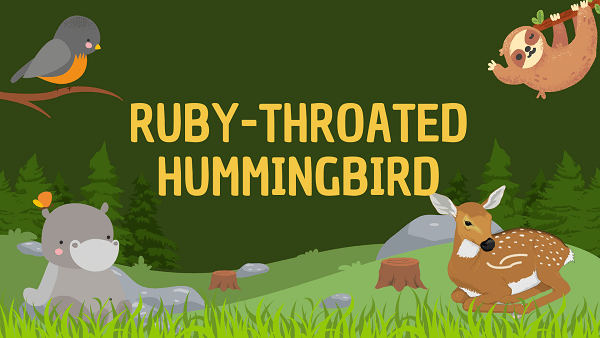Ruby-throated Hummingbird | Facts, Diet, Habitat & Pictures
Home » Animals » Ruby-throated Hummingbird | Facts, Diet, Habitat & Pictures
Ruby-throated Hummingbird Overview
Appearance
The Ruby-throated Hummingbird is a diminutive bird known for its vibrant and iridescent plumage. It features emerald-green upperparts and a white belly that shimmers in the sunlight. Males have a striking ruby-red throat patch, while females have a whitish throat and greenish sides.
These tiny birds have a slender and agile build, with long, pointed wings and a needle-like bill. Ruby-throated Hummingbirds are captivating with their jewel-like colors and rapid wing beats.
Origins And Evolution
The Ruby-throated Hummingbird (Archilochus colubris) boasts an intriguing evolutionary history within the Trochilidae family. Originating in North and Central America, these hummingbirds belong to the genus Archilochus.
Over time, they have adapted to diverse environments, evolving unique features such as specialized tongue structures for nectar feeding. Their evolution reflects their role as pollinators, with long bills and agile flight capabilities.
These tiny birds have become well-suited for extracting nectar from flowers, demonstrating remarkable aerial maneuvers. Their evolution showcases their critical ecological role in plant pollination and their remarkable ability to thrive in a range of habitats.
Behavior and Lifestyle
The Ruby-throated Hummingbird exhibits fascinating behavior and a distinctive lifestyle. These tiny birds are renowned for their agility, hovering in mid-air while feeding on nectar from flowers. They have a strong territorial nature, vigorously defending feeding and nesting sites.
Ruby-throated Hummingbirds also engage in long-distance migrations, covering thousands of miles between their breeding grounds in North America and wintering areas in Central America. Their iridescent plumage and rapid wing beats play a role in courtship displays, with males performing aerial shows to attract females.
Scientific Classification
- Kingdom: Animalia
- Phylum: Chordata
- Class: Aves
- Order: Apodiformes
- Family: Trochilidae
- Genus: Archilochus
- Species: Archilochus colubris
Locations
- Eastern and Central North America
- Eastern United States
- Eastern Canada
- Central America
- Mexico
- Breeding grounds in the eastern U.S. and Canada
- Wintering areas in Central America
- Coastal regions and gardens
Fast Facts
- Name: Ruby-throated Hummingbird
- Scientific Name: Archilochus colubris
- Habitat: Woodlands, Gardens
- Diet: Nectar, Insects
- Physical Features: Brilliant Plumage
- Nocturnal: Diurnal
- Solitary: Mostly Solitary
- Unique Order: Apodiformes
- Lifespan: 3-5 Years
- Conservation Status: Least Concern
- Fun Facts: Hovering Feeder, Fast Beating Wings1
Physical Characteristics
- Color: Iridescent Plumage
- Skin Type: Feathers Cover
- Top Speed: Rapid Flight
- Lifespan: 3-5 Years
- Weight: Lightweight Body
- Length: 3-4 Inches
- Age of Sexual Maturity: 1 Year
- Age of Weaning: 18-22 Days
FAQs
Why is it called the Ruby-throated Hummingbird?
Males have a bright ruby-red throat patch, which is a distinctive feature.
Where can I find Ruby-throated Hummingbirds?
They are primarily found in eastern and central North America, including the eastern United States and parts of Canada.
Do they migrate?
Yes, they migrate seasonally, traveling thousands of miles from their breeding grounds in North America to wintering areas in Central America.
What is their diet?
Ruby-throated Hummingbirds primarily feed on nectar from flowers, but they also eat insects and spiders for protein.
How fast do they fly?
They can reach speeds of up to 60 miles per hour (97 kilometers per hour) during steep dives.
Are they territorial?
Yes, they are known for their territorial behavior, especially around feeding and nesting sites.


